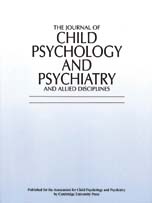Crossref Citations
This article has been cited by the following publications. This list is generated based on data provided by
Crossref.
Macdonald, Wendy
and
Bower, Peter
2000.
Child and adolescent mental health and primary health care: current status and future directions.
Current Opinion in Psychiatry,
Vol. 13,
Issue. 4,
p.
369.
Andrade, Laura
2000.
Surveys of morbidity and psychiatric comorbidity.
Current Opinion in Psychiatry,
Vol. 13,
Issue. 2,
p.
201.
Stemerdink, B. A.
Kalverboer, A. F.
van der Meere, J. J.
van der Molen, M. W.
Huisman, J.
de Jong, L. W. A.
Slijper, F. M. E.
Verkerk, P. H.
and
van Spronsen, F. J.
2000.
Behaviour and school achievement in patients with early and continuously treated phenylketonuria.
Journal of Inherited Metabolic Disease,
Vol. 23,
Issue. 6,
p.
548.
Jorm, A F
Prior, M
Sanson, A
Smart, D
Zhang, Y
and
Easteal, S
2000.
Association of a functional polymorphism of the serotonin transporter gene with anxiety-related temperament and behavior problems in children: a longitudinal study from infancy to the mid-teens.
Molecular Psychiatry,
Vol. 5,
Issue. 5,
p.
542.
PRIOR, MARGOT
SMART, DIANA
SANSON, ANN
and
OBERKLAID, FRANK
2000.
Does Shy-Inhibited Temperament in Childhood Lead to Anxiety Problems in Adolescence?.
Journal of the American Academy of Child & Adolescent Psychiatry,
Vol. 39,
Issue. 4,
p.
461.
Smart, Diana
Prior, Margot
Sanson, Ann
and
Oberklaid, Frank
2001.
Children with reading difficulties.
Australian Journal of Psychology,
Vol. 53,
Issue. 1,
p.
45.
Prior, Margot
Smart, Diana
Sanson, Ann
and
Oberklaid, Frank
2001.
Longitudinal Predictors of Behavioural Adjustment in Pre-Adolescent Children.
Australian & New Zealand Journal of Psychiatry,
Vol. 35,
Issue. 3,
p.
297.
Borge, Anne I.H.
Samuelsen, Sven Ove
and
Rutter, Michael
2001.
Observer variance within families: confluence among maternal, paternal and child ratings.
International Journal of Methods in Psychiatric Research,
Vol. 10,
Issue. 1,
p.
11.
Masi, Gabriele
Mucci, Maria
and
Millepiedi, Stefania
2001.
Separation Anxiety Disorder in Children and Adolescents.
CNS Drugs,
Vol. 15,
Issue. 2,
p.
93.
Clark, Cheryl
Prior, Margot
and
Kinsella, Glynda
2002.
The relationship between executive function abilities, adaptive behaviour, and academic achievement in children with externalising behaviour problems.
Journal of Child Psychology and Psychiatry,
Vol. 43,
Issue. 6,
p.
785.
Prichard, Zoë
Jorm, Anthony F.
Prior, Margot
Sanson, Ann
Smart, Diana
Zhang, Yafei
Huttley, Gavin
and
Easteal, Simon
2002.
Association of polymorphisms of the estrogen receptor gene with anxiety‐related traits in children and adolescents: A longitudinal study.
American Journal of Medical Genetics,
Vol. 114,
Issue. 2,
p.
169.
Bayer, Jordana K.
and
Sanson, Ann V.
2003.
Preventing the Development of Emotional Mental Health Problems from Early Childhood: Recent Advances in the Field.
International Journal of Mental Health Promotion,
Vol. 5,
Issue. 3,
p.
4.
Barton, Joanne
2003.
Conduct Disorder: Intervention and Prevention.
International Journal of Mental Health Promotion,
Vol. 5,
Issue. 4,
p.
32.
Letcher, Primrose
Toumbourou, John
Sanson, Ann
Prior, Margot
Smart, Diana
and
Oberklaid, Frank
2004.
Parenting style as a moderator of the effect of temperament on adolescent externalising and internalising behaviour problems.
The Australian Educational and Developmental Psychologist,
Vol. 19,
Issue. 2,
p.
5.
Heaven, Patrick C.L
Newbury, Kathryn
and
Mak, Anita
2004.
The impact of adolescent and parental characteristics on adolescent levels of delinquency and depression.
Personality and Individual Differences,
Vol. 36,
Issue. 1,
p.
173.
Macdonald, Wendy
Bradley, Sally
Bower, Peter
Kramer, Tami
Sibbald, Bonnie
Garralda, Elena
and
Harrington, Richard
2004.
Primary mental health workers in child and adolescent mental health services.
Journal of Advanced Nursing,
Vol. 46,
Issue. 1,
p.
78.
STOCKWELL, TIM
TOUMBOUROU, JOHN W.
LETCHER, PRIMROSE
SMART, DIANA
SANSON, ANN
and
BOND, LYNDAL
2004.
Risk and protection factors for different intensities of adolescent substance use: when does the Prevention Paradox apply?.
Drug and Alcohol Review,
Vol. 23,
Issue. 1,
p.
67.
Prior, Margot
Virasinghe, Shanya
and
Smart, Diana
2005.
Behavioural problems in Sri Lankan schoolchildren.
Social Psychiatry and Psychiatric Epidemiology,
Vol. 40,
Issue. 8,
p.
654.
Suveg, Cynthia
Aschenbrand, Sasha G.
and
Kendall, Philip C.
2005.
Separation Anxiety Disorder, Panic Disorder, and School Refusal.
Child and Adolescent Psychiatric Clinics of North America,
Vol. 14,
Issue. 4,
p.
773.
Smart, Diana
Prior, Margot
Sanson, Ann
and
Oberklaid, Frank
2005.
Children with reading difficulties: A six year follow‐up from early primary school to secondary school.
Australian Journal of Learning Disabilities,
Vol. 10,
Issue. 3-4,
p.
63.


